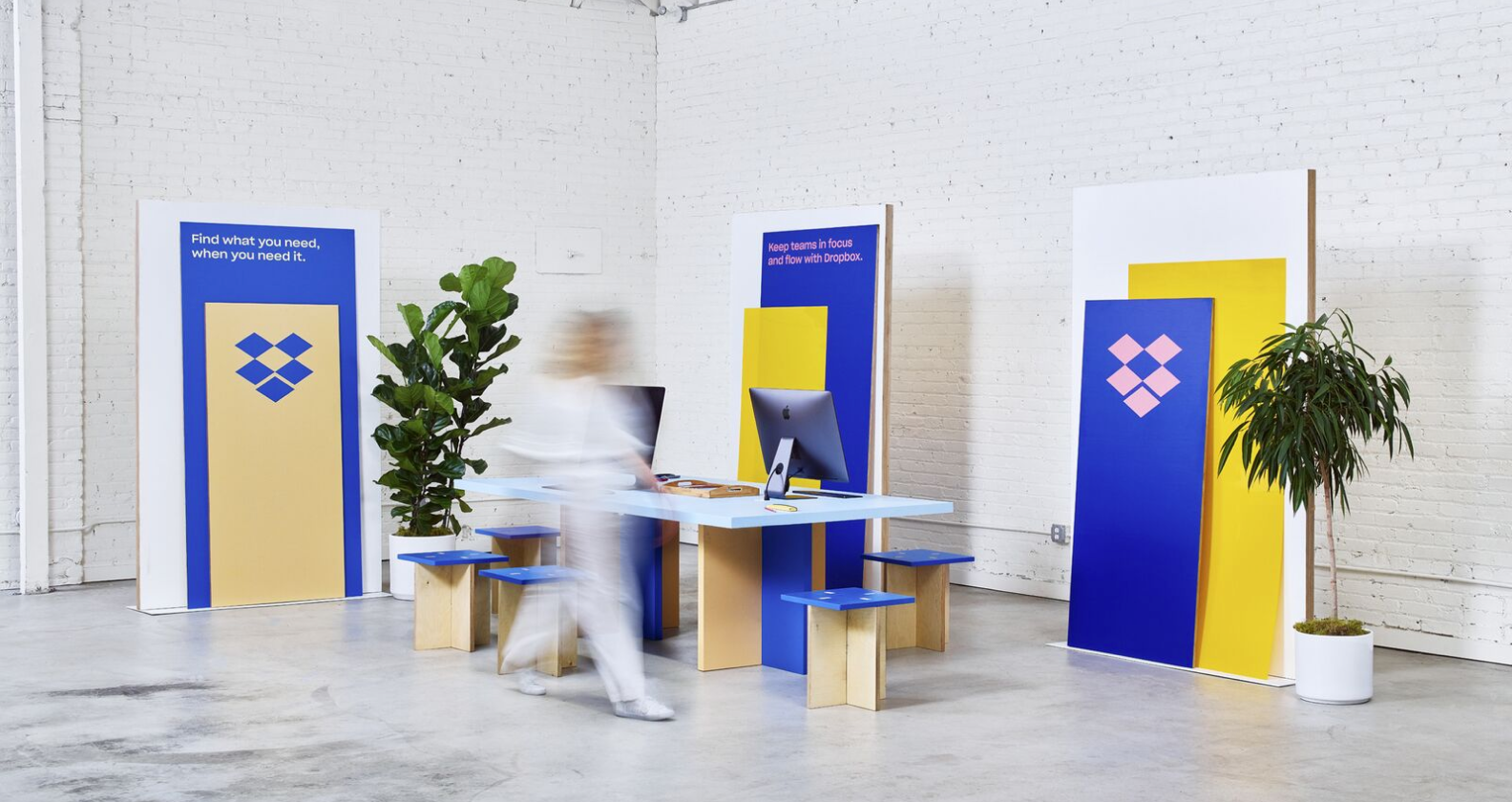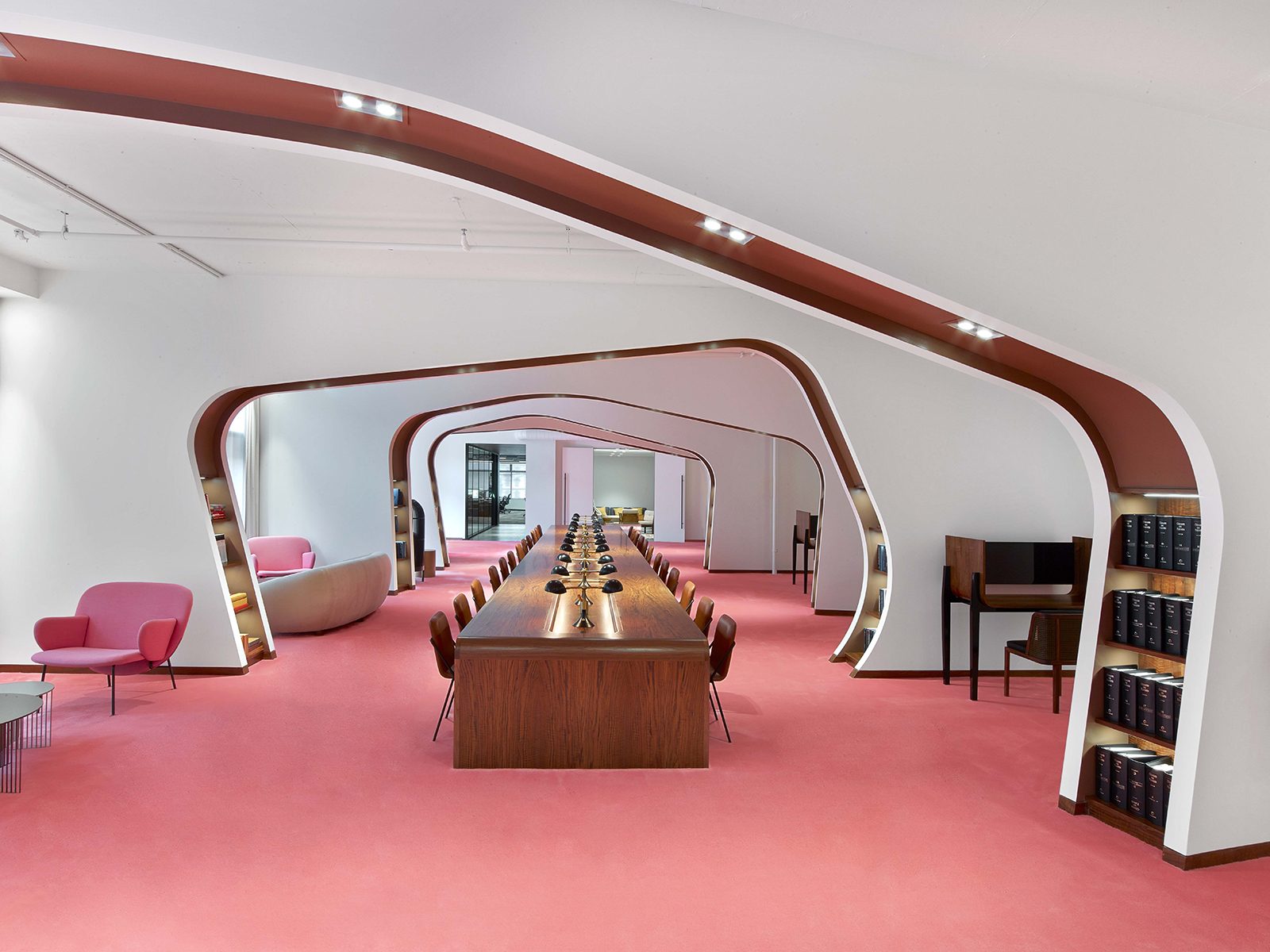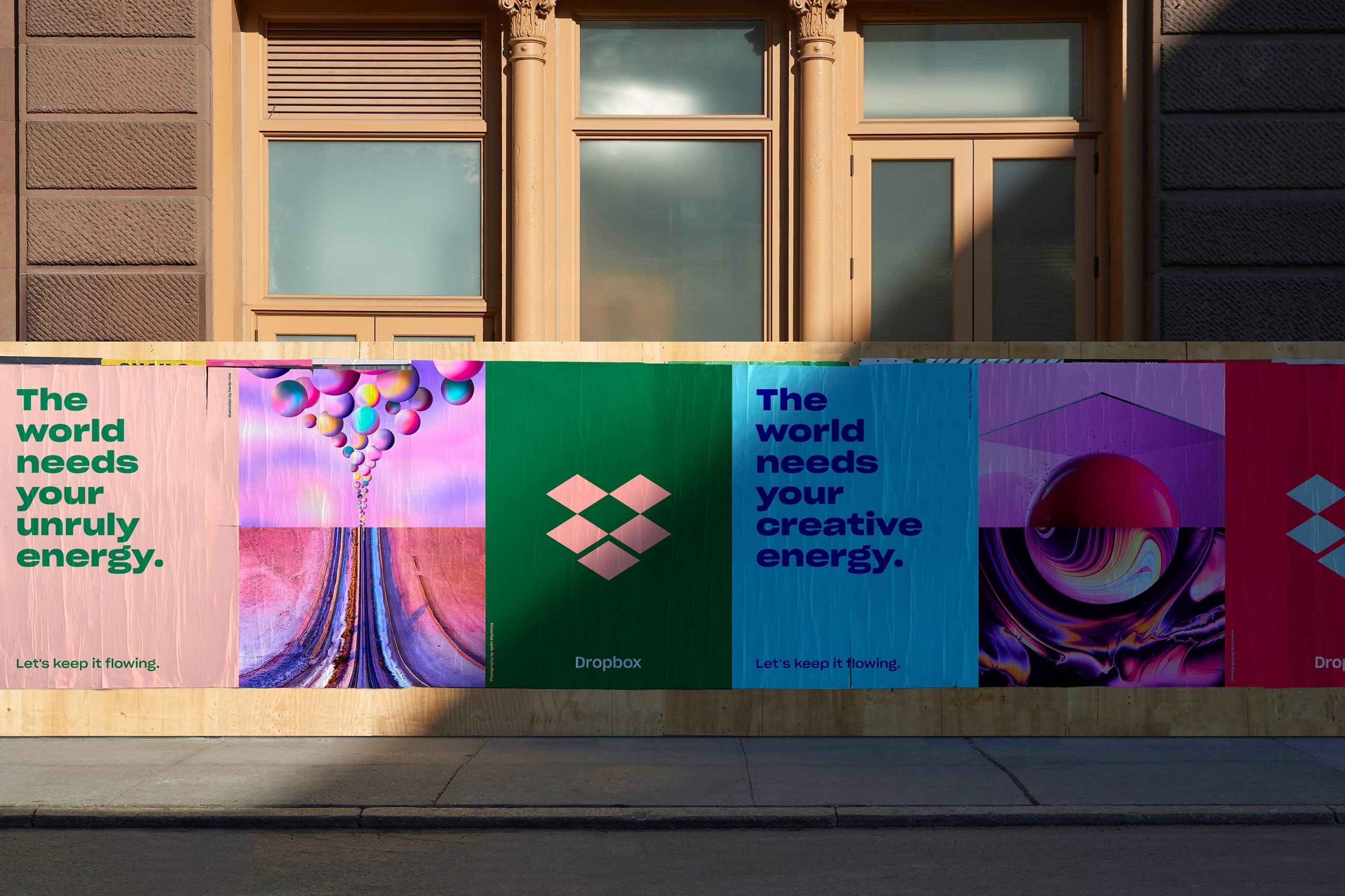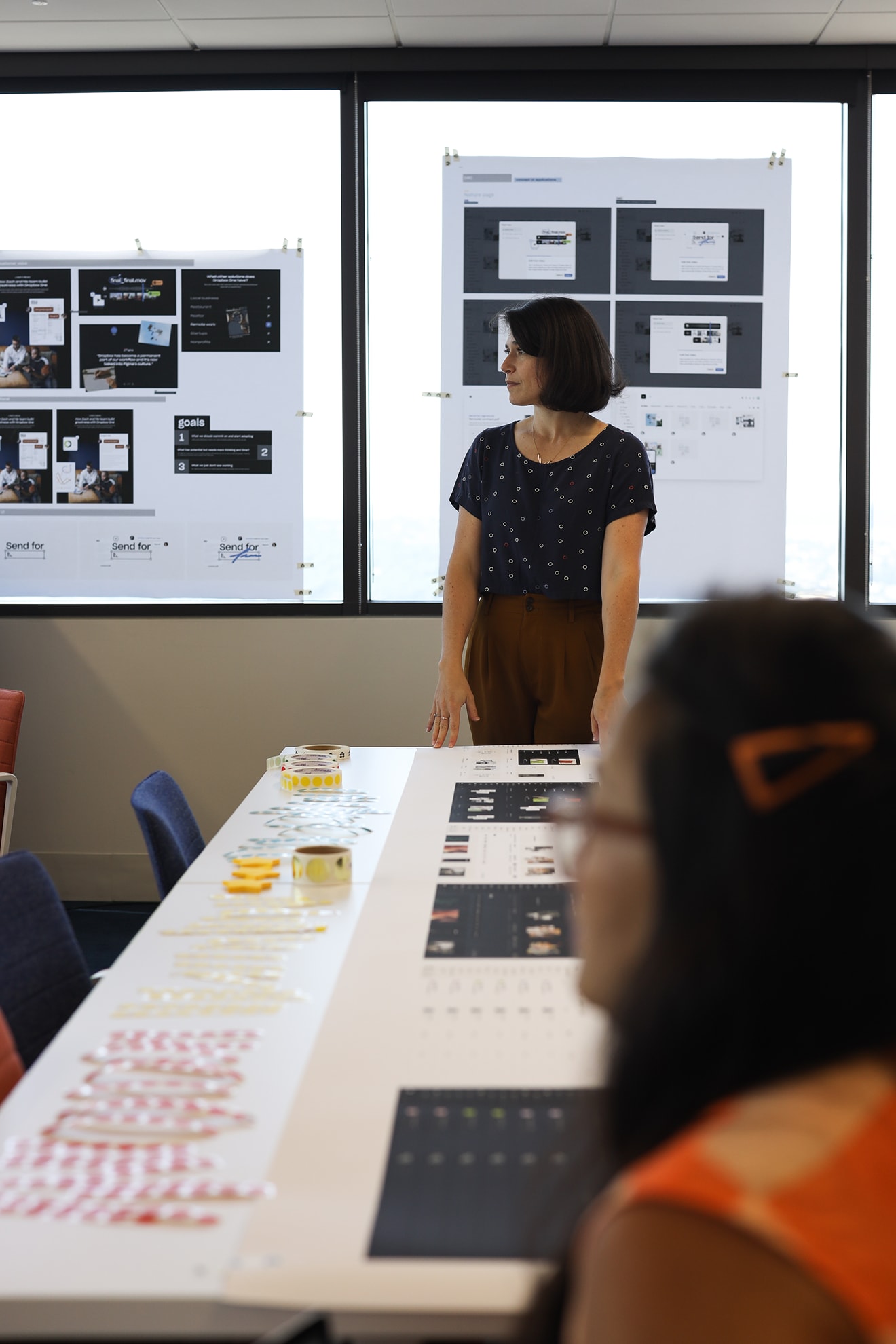Product Principles
Dropbox users are just like us: Short on time, fighting to stay focused, and always looking for ways to wrangle the chaos and be more effective.
Product Principles
Dropbox users are just like us: Short on time, fighting to stay focused, and always looking for ways to wrangle the chaos and be more effective.
Dropbox • values
01
It just works
No one wants to read an instruction manual for their software. If the user has to spend their time figuring it out, we don’t ship it. An effortless experience means all of Dropbox works together. Period. Be aware of other projects and make sure everything clicks as system.
Dropbox • values
02
Give it focus
No one is asking for more choices. They are asking for better ones. In a world with endless options, attention is a user’s most valuable resource. Don’t waste it. If something’s already been built, don’t build it again. Add things that serve our users’ needs. Be ruthless in removing anything that doesn’t.
Dropbox • values
03
Make it magical
No matter what you do, work is still work. Our goal is to spark smiles along the way. Look for opportunities to make it joyful. Celebrate a completed task. Automate the next one. This isn’t just about visual flourish. It’s about the satisfaction delivered by tech that gets you.
Showcase
Browse a diverse collection of our designs and references to see what inspires us.


























Meet the Team
Dive into the inner workings of the Portfolio Design Team and their motivations.






Why did you join Dropbox?
 CS
CSDropbox is a very design-centric company that has a long-standing design culture, and a very clear impact on the broader design community. That's something that's really important to me. Additionally, I missed the long-term impact that you can have when you work somewhere in-house, and getting to be an IC leader is something that I feel Dropbox is modeling for other companies.
 CM
CMI joined because I wanted to work somewhere where the work mattered in people's lives. The value we provide as a company is truly trying to help people recapture time and energy so that they can give back to their families, communities, and people they care about. So in that way, it feels very easy to be committed to the work.
 AL
ALOne of the most unique things about Dropbox is its core mission—to design a more enlightened way of working. There's a deep, almost sacrificial humility in how Dropbox approaches its work. We genuinely strive to be customer-obsessed, not just in words but in building experiences that empower users to extract more value from the platform.
What really makes Dropbox stand out for me is its emphasis on design. We are intentionally putting design at the forefront of decision-making and leadership, which is a journey that takes time, especially when it comes to transforming internal and external culture.
What is the Portfolio Design Team at Dropbox about?
The Portfolio Design team is a group of Senior Principal, Principal, and Staff Designers whose job is to set design direction, connect dots across the customer experience, and improve the quality of what we put in customer's hands. We tackle both breadth and depth within the company, working through challenges that require rich expertise and deep customer understanding.
The Portfolio Design team was formed from a simple observation: Siloed teams who are moving fast unintentionally ship disjointed experiences. By putting our team in between product teams, we're taking Dropbox to a premium, thoughtfully designed portfolio of tools, hence the team name.




What project are you proud of?
 CM
CMOur team worked on the web redesign project for quite some time and we all contributed in so many different ways. I worked on this project for its entirety, from the early stages of trying to build the core thesis around why change was necessary, to the final, finished result.
We weren’t just looking at how the experience had become disjointed, but we were also trying to surface opportunities for huge improvement. By bringing in new business opportunities and strategy, we created a new information architecture that would allow for big bets we were making to better land with customers.
What was the biggest change you were pushing for?
 CM
CMPreviously, we had a user experience that directed users to separate, loosely connected products, causing friction and difficulties in navigation. For example, if someone was trying to quickly edit a PDF, add signature fields, have the document signed, then store and track it, this experience would have taken them to three different products with different identity backend systems. We knew this wasn’t working for our customers. With this in mind, we focused on integration and building common UX patterns so that our users now feel like they can accomplish work much more fluidly and naturally.
What limitations did you feel at previous companies, and how is that different today at Dropbox?
 CS
CSAt other places I've worked, a lot of the strategic work was centred more around management. So to be a contributor to a product's strategy as a designer, you essentially needed to consider taking on reports. While that is a very admirable direction to take your career, there's also a lot of value in bringing a perspective that is more within the realm of craft.
Thinking about how you apply the design system to the actual product and thinking at a more complex level is incredibly interesting to me. I find myself much more closely aligned with being very hands-on and getting to dig into all ends of the experience.
What I appreciate about working at Dropbox is that our collaborators often are actually directors, and we’re in active conversations with executives and senior leaders. They want to hear our feedback and thinking, and we're driving those conversations a lot of the time.
What do you find challenging with your work?
 CM
CMOne thing that is unique about Dropbox relative to other companies is that we're in a period of transformation. Some companies hit product-market fit, they're a startup, and are in a moment of scaling to more geographies and more customers. We've already done that as a company in our first big act.
Now we're entering our second act of transformation and new market opportunities. A lot of our transformation involves AI and new technologies, and there's a lot of ambiguity in terms of the technologies that are going to power this next revolution.
People who are successful in this phase are typically ones who enjoy and want to take on the challenge of being part of that transformation.
What excites you the most about your future at Dropbox?
 AL
ALThere’s a potential here to create an entirely new paradigm for how users interact with their systems. Traditionally, we’ve designed interfaces to help people tell machines what they want, but now we’re entering a new era where machine learning and generative AI are becoming part of the conversation. This opens up opportunities to design interfaces that foster unstructured collaboration in ways we've never seen before.
How are you finding working remotely?
 CM
CMWe have a concept called 'core collaboration hours,' which is a four-hour window that overlaps across time zones and is reserved for synchronous collaboration, like meetings. As a maker, I find this tremendously valuable because I can do deep work outside of that window. For example, my mornings in Central Time allow me to be incredibly productive. In my last job, I had meetings scattered from eight in the morning till five in the evening, which hindered my ability to be productive and focus.
 CS
CSBuilding on that, with this framework, we're asking ourselves, "Does this need to be a live, synchronous conversation? Is there another format that could be as impactful or potentially save us time?" Over time, especially as a more senior designer, you accumulate numerous one-on-one meetings from past projects across different parts of the organization. At Dropbox, there is encouragement to audit our calendars very actively, and this practice is incredibly helpful.





What kind of people thrive at Dropbox, and what skills are needed for success?
 CS
CSYou need to embrace ambiguity and feel excited by it. Embrace the feeling of being challenged, push past it, and dive into the fear of the unknown. I believe that people who tend to be biased towards action are particularly valuable on this team, but in general, the more you can create momentum and understand when to push things forward, the better here at Dropbox. It's crucial to ensure that you're generating energy and sharing the vision to get people excited and motivated to move forward together.
 CM
CMI might also add deep empathy for the customers we're trying to serve and a ruthless commitment to crafting great experiences. This entails caring deeply about interaction details, typography, visual design, motion design, and all the fundamentals that contribute to creating a memorable experience. We have the opportunity to be extensively involved in the creation process and set the tone for the design throughout the organization.
Where can people learn more about working for Dropbox?
They can check out jobs.dropbox.com
Workspaces
Take a peek into the workspace of the Dropbox Portfolio team.



 SZ
SZ
 SZ
SZ
 AL
AL
 AL
AL
 CS
CS
 CS
CS
 MW
MW
 MW
MW
 CM
CM
 CM
CMCurated
A curated collection of our favorite books, podcasts, music, and more, hand-picked by our team for your enjoyment.

 AL
AL
 AL
AL
 AL
AL
 AL
AL
 AL
AL
 AL
AL
 AL
AL
 AL
AL
 CM
CM
 CM
CM
 CM
CM
 CM
CM
 CM
CM
 CM
CM
 CS
CS
 CS
CS
 CS
CS
 CS
CS
 CS
CS
 CS
CS
 CS
CS
 CM
CM
 CM
CM
 CM
CM
 CM
CM
 MW
MW
 MW
MW
 MW
MW
 MW
MW
 SZ
SZ
 SZ
SZ
 SZ
SZ
 SZ
SZ
 SZ
SZ
 SZ
SZ
 SZ
SZ
 SZ
SZ
 SZ
SZ
 SZ
SZ
 SZ
SZ
 SZ
SZ





